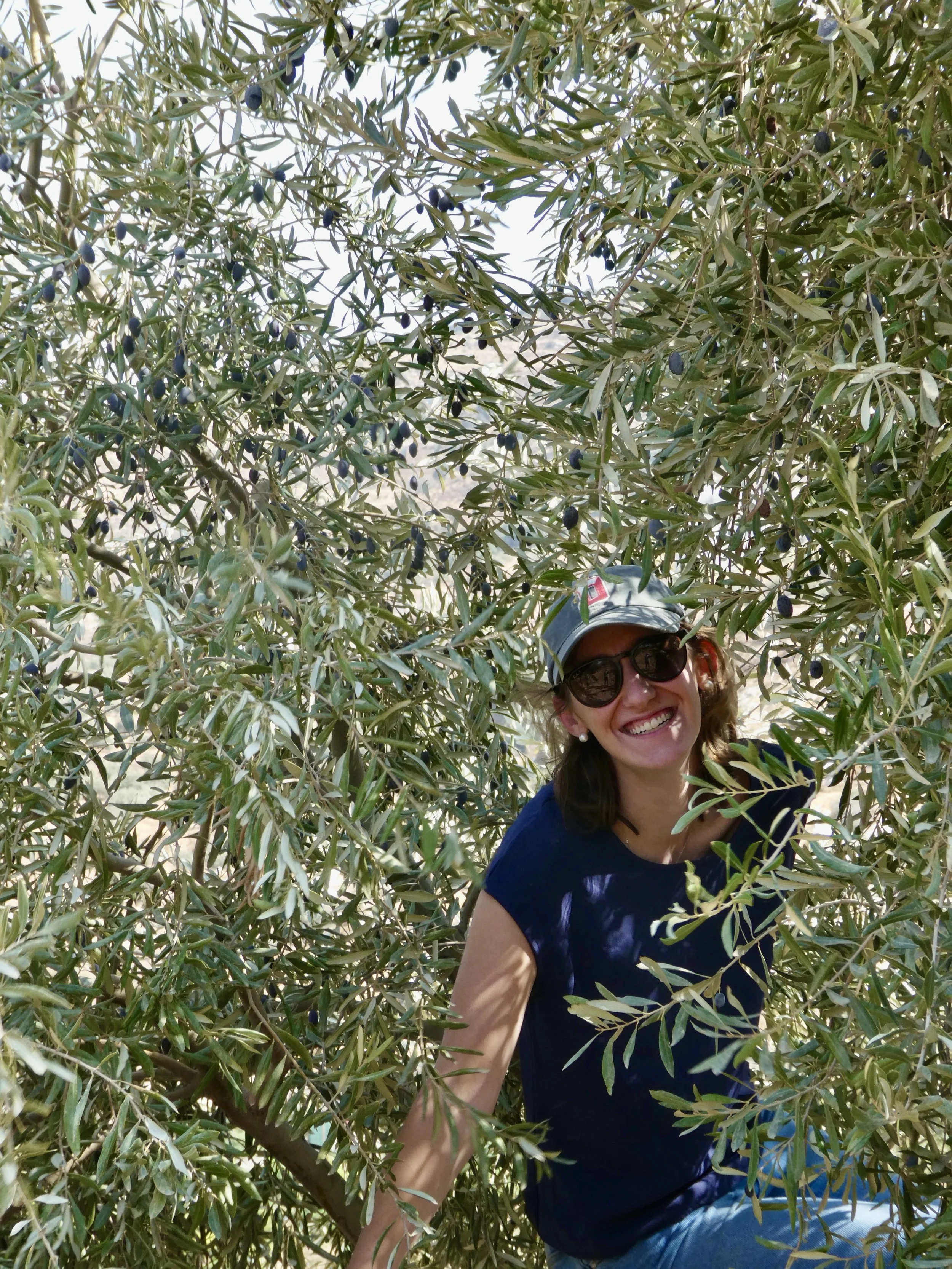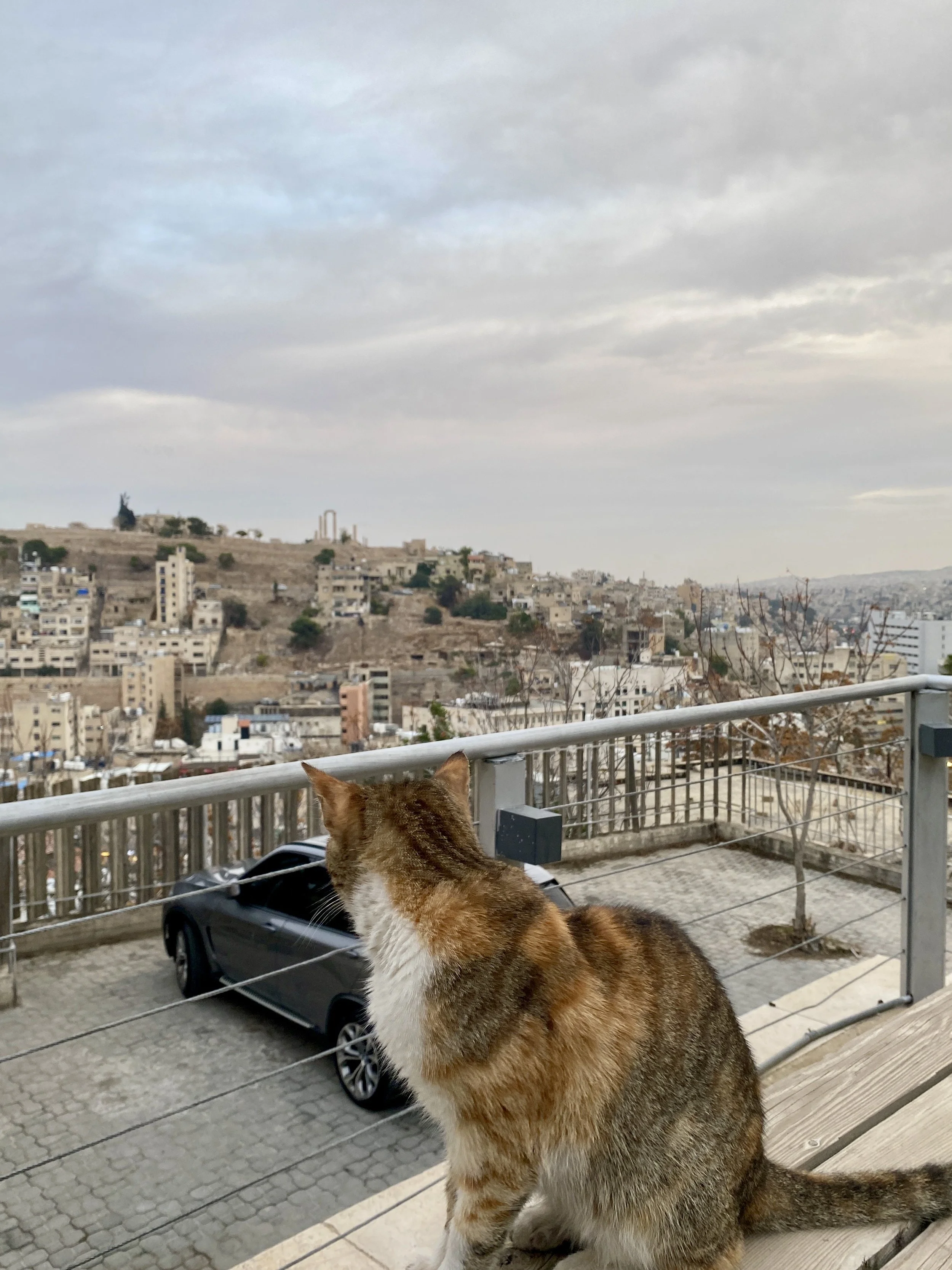"بنت الزيتون - Girl of the Olives" by Xenia Makosky
Ever since I was a little girl, I have loved olives. I know. I know. It’s a strange food for a little kid to love, but my dad always used to give my brother and me olives for snacks, and we always had special olives for birthdays and celebrations. My American family is also a big consumer of olive oil, and we usually go through several large gallon sized containers every year. I have always wanted to stand in a field of olive trees and become an olive farmer, even for just one day. Learning Arabic has paired remarkably well with my love for olives. Olive trees equal 80% of all cultivated trees in Jordan, and one of the things I was most looking forward to while studying abroad was getting to see a native olive tree for the first time in my life. This dream ended up coming true during fall break when Amideast organized an excursion for us to a Jordanian family’s olive farm.
The farm that we went to was in Balqa province and was a little over an hour away from Amman. When we got to the farm the family welcomed us with plates of fruit and Arabic coffee. They also sat down with us and started telling us about olive harvesting in Jordan.
The olive picking season usually runs from mid-October to December, and traditionally during this time farmers and their families would work in the fields together harvesting olives and singing songs. Unfortunately, due to economic and social changes, this tradition is starting to fade, and there are paid workers that usually do most of the harvesting.
Olives in Jordan are harvested manually. Blankets, or tarps, are placed at the bottom of each tree and then when the olives fall onto it they make a pitter patter sound like rain drops! Sometimes farmers use a special tool that looks like a comb to brush through the branch to make the olives fall off the branches. If you do not have a special tool, then you can also use your hand and mirror the same technique. There were at least 10 children from the family who were also helping us harvest olives, and they were experts at this technique! They were above our heads and showering olives down on us.
One of the interesting aspects of the day was seeing the effects of climate change on olive farming. When we first arrived, we saw olives harvested from the previous day laying out on a tarp. We asked if there were two types of olives in the pile because most were black, but then there were a few round plump green ones in the mix. The farmer explained that all the olives are the same type, but the plump green ones are the ones that got a significant amount of water. The majority of the olives were black because this year was a particularly dry year. While the black olives are still able to produce good quality oil, they do not produce as much oil as the few fat green olives in the pile.
While olive trees are fairly drought resistant, they, like every other plant in the world, also need water. Usually, farmers rely on only the rainwater for irrigation, but due to changing weather patterns they are having to sometimes buy water for the trees. Olive farming relies heavily on science, and temperature tolerance, water consumption, and photosynthesis all play a part in cultivation. If global temperatures continue to rise and water instability continues, then the amount and quality of olives will decrease. This is just one more reminder of how climate change is continuing to impact global food patterns.
After picking olives in the morning, we sat down to an amazing meal prepared by the family. We ate lamb sajina (a type of grilled meat), potatoes, zait and zatar, (olive oil bread dipped in thyme,) matbucha (a tomato dip), olives, fresh vegetables, lebnah (a type of yogurt), halwa (a sweet pistachio spread), and fresh green onions. I am not exaggerating when I say this was one of the most memorable and delicious meals of my life.
The term “hospitable” does not do justice to our hosts. We all felt overwhelmingly loved and welcomed when we arrived at the farm. What continues to amaze me is the fact that this Jordanian family did not know us personally before we came. They just knew there was a group of American students and their language partners who were coming for the day, and they graciously opened their home to us. This overwhelming type of hospitality will always stay with me.
After lunch we headed over to one of the local olive presses, and we got to see local olives washed and then put through the press. At the end of the short tour, we tasted fresh pressed olive with fresh bread. The olive oil was light green and had a slightly spicy taste. As time passes, the olive oil will lose the green color and become a dark gold color.
Here’s a short video clip of fresh olive oil gushing out of the press. Video Credit: Makosky, 2022.
While most Americans just go to the grocery store and buy a random tiny bottle of olive oil from the shelf, this is the exact opposite of how Jordanian families buy their olive oil. While every Jordanian family is different, most families will buy and use one or two tanaka (تنكة) of olive oil every year. A tanka is equal to approximately 16 liters or around 4.2 gallons. These containers are huge and rightly so, expensive. Usually, the price for one tanaka ranges between 80-100 JOD. This year, due to the weather patterns and because it was a resting year for many olive trees, the cost is running around 90-95 JOD.
Jordanian families are also extremely picky about where their olive oil is from and who they buy it from. Some families, like my host family, want the oil to come from their family's home region. Some Jordanians have family establishments that buy and then sell and distribute oil to the family members. Other Jordanians go straight to the farmer and olive press. No matter whom you ask, though, everybody will tell you that you must buy your oil from a trustworthy person. Olive oil is used in every single dish Jordanians make, so it is extremely important that the oil is pure and high quality.
Oh, and just one more note about olives. You cannot just pick an olive off a tree and eat it. It will not taste good. Most types of olives need to go through a curing process before you can eat them.
Maybe olive harvesting is not on Trip Advisor’s list of top activities to do in Jordan, but to me that’s the whole point. Quiet and intimate moments like sitting under olive trees and hearing Friday prayers echoing through the valley while a family harvests olives are Jordan to me, not Wadi Rum, or a bustling market downtown, or Aqaba, or Jerash, or even Petra. While tourists might be drawn to loud, bustling, and fast-paced activities, spending a day in the olive fields taught me more about Jordan and her people than any other activity I have experienced thus far. Unconditional hospitality in a land full of millions of olive trees is the real Jordan, and I hope that one day you are also able to experience it.
Xenia Makosky is a student from Dickinson College participating on Amideast’s Area and Arabic Language Studies program in Amman, Jordan in Fall 2022.






